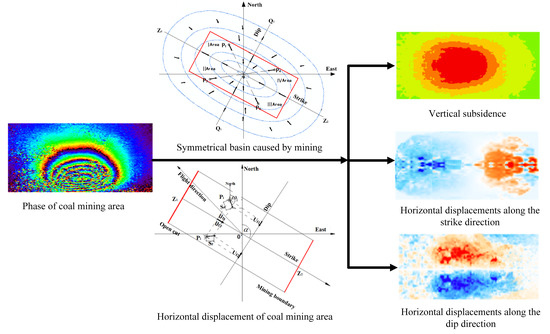Time Series InSAR Three-Dimensional Displacement Inversion Model of Coal Mining Areas Based on Symmetrical Features of Mining Subsidence
Abstract
1. Introduction
2. Methodology
2.1. Symmetry Analysis of Mining Areas Based on Mining Theory
2.2. Geometric Relationship between the Radar LOS Direction and 3-D Direction
2.3. The SGI-SF Method for Deriving Time Series 3-D Displacement Fields
2.3.1. The SGI-SF Inversion Method at Pixel Level
2.3.2. Deriving Time Series 3-D Displacement Fields
2.3.3. Determining the Center of the Dynamic Surface Movement Basin
- The subsidence value of the center point O’ in the moving basin should be the maximum value in the whole major cross section along strike direction; and
- The absolute value of the horizontal displacement at the center point O’ in the moving basin should be close to zero.
- Number the pixel displacement on the major cross section along strike direction in the LOS displacement map (LOS1, LOS2, LOS3, LOS4…LOSn−2, LOSn−1, LOSn). As the center of the basin cannot deviate beyond the mined-out areas, the search can start from the open cut.
- Select the displacement values of pixel 1 and pixel 2, express them with dLOSA and dLOSB, and substitute them into Equation (15).
- The displacement values of pixel 2 and pixel 3 are selected and assigned to dLOSA and dLOSB, respectively. The subsidence and horizontal displacement values of pixel 2 and pixel 3 are calculated from Equations (7) and (8) and recorded as the second group displacement (W2, UT2).
- This process continues until the subsidence and horizontal displacement values of pixels N-1 and N are calculated and recorded as a group of N−1 data, forming an array of displacement values (W1, UT1), (W2, UT2)… (WN−1, UT(N−1)). The calculation flow is shown in Figure 5.
- By comparing the above (n−1) values, the pixel group with the largest subsidence value and the pixel group with the smallest absolute value of horizontal displacement are found. When the two pixel groups are the same, the middle position of this pixel group is the center point O’ of the moving basin. When the two pixel groups conflict, the middle position of the group with the largest subsidence value is preferred as the basin center O’.
3. Study Area and Datasets
3.1. Study Area
3.2. SAR Data Selection and Data Processing
4. Results
4.1. Estimation of Time Series 3-D Displacements
4.2. Verification
5. Discussion
6. Conclusions
Author Contributions
Funding
Data Availability Statement
Acknowledgments
Conflicts of Interest
References
- Yang, Z.; Li, Z.; Zhu, J.J. InSAR-based model parameter estimation of probability integral method and its application for predicting mining-induced horizontal and vertical displacements. IEEE Trans. Geosci. Remote Sens. 2016, 54, 4818–4832. [Google Scholar] [CrossRef]
- Boone, S.J. Ground-movement-related building damage. J. Geotech. Eng. 1996, 122, 886–896. [Google Scholar] [CrossRef]
- Malinowska, A.; Hejmanowski, R. Building damage risk assessment on mining terrains in Poland with GIS application. Int. J. Rock Mech. Min. Sci. 2010, 47, 238–245. [Google Scholar] [CrossRef]
- Saeidi, A.; Deck, O.; Verdel, T. Comparison of building damage assessment methods for risk analysis in mining subsidence regions. Geotech. Geol. Eng. 2013, 31, 1073–1088. [Google Scholar] [CrossRef][Green Version]
- Yang, Z.F.; Li, Z.W.; Zhu, J. Deriving dynamic subsidence of coal mining areas using InSAR and logistic model. Remote Sens. 2017, 9, 125. [Google Scholar] [CrossRef]
- Carne, C.; Delacourt, C. Three years of mining subsidence monitored by SAR interferometry, near Gardanne, France. J. Appl. Geophys. 2000, 43, 43–54. [Google Scholar] [CrossRef]
- Ge, L.; Rizos, C.; Han, S. Mining Subsidence Monitoring Using the Combined InSAR and GPS Approach. In Proceedings of the 10th International Symposium on Deformation Measurements, Orange, CA, USA, 19–22 March 2001; pp. 1–10. [Google Scholar]
- Ng, A.; Chang, H.C.; Ge, L. Assessment of radar interferometry performance for ground subsidence monitoring due to underground mining. Earth Planets Space 2009, 61, 733–745. [Google Scholar] [CrossRef]
- Soole, K. Displacement monitoring and visualisation using terrestrial photogrammetry. In Proceedings of the 5th Mine Subsidence Technology Society Conference, Maitland, NSW, Australia, 26–28 August 2001; pp. 181–187. [Google Scholar]
- Mills, K.W. Developments in understanding subsidence with improved monitoring. In Proceedings of the 8th Conference on Mine Subsidence, Hunter Valley, NSW, Australia, 15–17 May 2011; pp. 25–41. [Google Scholar]
- Samsonov, S.; d’Oreye, N.; Smets, B. Ground deformation associated with post-mining activity at the French- German border revealed by novel InSAR time series method. Int. J. Appl. Earth Obs. 2013, 23, 142–154. [Google Scholar] [CrossRef]
- Ferretti, A.; Savio, G.; Barzaghi, R. Submillimeter accuracy of InSAR time series: Experimental validation. IEEE Trans. Geosci. Remote Sens. 2007, 45, 1142–1153. [Google Scholar] [CrossRef]
- Pepe, A.; Calò, F. A review of interferometric synthetic aperture RADAR (InSAR) multi-track approaches for the retrieval of Earth’s surface displacements. Appl. Sci. 2017, 7, 1264. [Google Scholar] [CrossRef]
- Raucoules, D.; Maisons, C.; Camec, C.; Le Mouelic, S.; King, C.; Hosford, S. Monitoring of slow ground deformation by ERS radar interferometry on the Vauvert salt mine (France): Comparison with ground-based measurement. Remote Sens. Environ. 2003, 88, 468–478. [Google Scholar] [CrossRef]
- Wang, C.; Zhang, Z.; Zhang, H.; Wu, Q.; Zhang, B.; Tang, Y. Seasonal deformation features on Qinghai–Tibet railway observed using time-series InSAR technique with high-resolution TerraSAR-X images. Remote Sens. Lett. 2017, 8, 1–10. [Google Scholar] [CrossRef]
- Wang, C.; Zhang, Z.; Zhang, H.; Zhang, B.; Tang, Y.; Wu, Q. Active Layer Thickness Retrieval of Qinghai–Tibet Permafrost Using the TerraSAR-X InSAR Technique. IEEE J. Sel. Top. Appl. Earth Obs. Remote Sens. 2018, 11, 4403–4413. [Google Scholar] [CrossRef]
- Wang, J.; Wang, C.; Zhang, H.; Tang, Y.; Zhang, X.; Zhang, Z. Small-Baseline Approach for Monitoring the Freezing and Thawing Deformation of Permafrost on the Beiluhe Basin, Tibetan Plateau Using TerraSAR-X and Sentinel-1 Data. Sensors 2020, 20, 4464. [Google Scholar] [CrossRef]
- Hartwig, M.E.; Paradella, W.R.; Mura, J.C. Detection and monitoring of surface motions in active open pit iron mine in the Amazon Region, using persistent scatterer interferometry with terrasar-x satellite data. Remote Sens. 2013, 5, 4719–4734. [Google Scholar] [CrossRef]
- Zhao, C.; Lu, Z.; Zhang, Q. Time-series deformation monitoring over mining regions with SAR intensity -based offset measurements. Remote Sens. Lett. 2013, 4, 436–445. [Google Scholar] [CrossRef]
- Paradella, W.R.; Ferretti, A.; Mura, J.C.; Galo, M.; Camargo, P.O.; Gama, F.F.; Tamburini, A.; Santos, R.A.; Novali, F.; Galo, M.; et al. Mapping surface deformation in open pit iron mines of Carajas Province (Amazon Region) using an integrated SAR analysis. Eng. Geol. 2015, 193, 61–78. [Google Scholar] [CrossRef]
- Zebker, H.A.; Villasenor, J. Decorrelation in interferometric radar echoes. IEEE Trans. Geosci. Remote Sens. 1992, 30, 959. [Google Scholar] [CrossRef]
- Massonnet, D.; Feigl, K.L. Radar interferometry and its application to changes in the Earth’s surface. Rev. Geophys. 1998, 36, 441–500. [Google Scholar] [CrossRef]
- Ferretti, A.; Prati, C.; Rocca, F. Permanent scatterers in SAR interferometry. IEEE Trans. Geosci. Remote Sens. 2001, 39, 8–20. [Google Scholar] [CrossRef]
- Berardino, P.; Fornaro, G.; Lanari, R.; Sansosti, E. A new algorithm for surface deformation monitoring based on small baseline differential SAR interferograms. IEEE Trans. Geosci. Remote Sens. 2002, 40, 2375–2383. [Google Scholar] [CrossRef]
- Werner, C.; Wegmuller, U.; Strozzi, T.; Wiesmann, A. Interferometric point target analysis for deformation mapping. In Proceedings of the 2003 IEEE International Geoscience and Remote Sensing Symposium, Toulouse, France, 21–25 July 2003; pp. 4362–4364. [Google Scholar]
- Hooper, A.; Zebker, H.; Segall, P.; Kampes, B. A new method for measuring deformation on volcanoes and other natural terrains using InSAR persistent scatterers. Geophys. Res. Lett. 2004, 31. [Google Scholar] [CrossRef]
- Perissin, D.; Wang, T. Time-Series InSAR Applications Over Urban Areas in China. IEEE J. Stars. 2011, 4, 92–100. [Google Scholar] [CrossRef]
- Costantini, M.; Falco, S.; Malvarosa, F.; Minati, F.; Trillo, F.; Vecchioli, F. Persistent Scatterer Pair Interferometry: Approach and Application to COSMO-SkyMed SAR Data. IEEE J. Stars. 2014, 7, 2869–2879. [Google Scholar] [CrossRef]
- Kampes, B.M.; Hanssen, R.F. Ambiguity resolution for permanent scatterer interferometry. IEEE Trans. Geosci. Remote Sens. 2004, 42, 2446–2453. [Google Scholar] [CrossRef]
- Wright, P.; Stow, R. Detecting mining subsidence from space. Int. J. Remote Sens. 1999, 20, 1183–1188. [Google Scholar] [CrossRef]
- Colesanti, C.; Mouelic, S.; Bennani, M.; Raucoules, D.; Carnec, C.; Ferretti, A. Detection of mining related ground instabilities using the permanent scatterers technique—a case study in the east of France. Int. J. Remote Sens. 2005, 26, 201–207. [Google Scholar] [CrossRef]
- Mura, J.C.; Paradelle, W.R.; Gama, F.F.; Silva, G.G.; Galo, M.; Camargo, P.O.; Silva, A.Q.; Silva, A. Monitoring of non-linear ground movement in an open pit iron mine based on an integration of advanced DInSAR techniques using TerraSAR-X data. Remote Sens. 2016, 8, 409. [Google Scholar] [CrossRef]
- Dong, S.; Samsonov, S.; Yin, H.; Yao, S.; Xu, C. Spatio-temporal analysis of ground subsidence due to underground coal mining in Huainan coalfield, China. Environ. Earth Sci. 2015, 73, 5523–5534. [Google Scholar] [CrossRef]
- Grzovic, M.; Ghulam, A. Evaluation of land subsidence from underground coal mining using TimeSAR (SBAS and PSI) in Springfield, Illinois, USA. Nat. Hazards 2015, 79, 1739–1751. [Google Scholar] [CrossRef]
- Zhang, Z.; Wang, C.; Tang, Y.; Zhang, H.; Fu, Q. Analysis of ground subsidence at a coal-mining area in Huainan using time-series InSAR. Int. J. Remote Sens. 2015, 36, 5790–5810. [Google Scholar] [CrossRef]
- Zhang, Z.; Wang, C.; Tang, Y.; Fu, Q.; Zhang, H. Subsidence monitoring in coal area using time-series InSAR combining persistent scatterers and distributed scatterers. Int. J. Appl. Earth Obs. Geoinf. 2015, 39, 49–55. [Google Scholar] [CrossRef]
- Strozzi, T.; Wegmuller, U.; Werner, C.; Wiesmann, A.; Spreckels, V. JERS SAR interferometry for land subsidence monitoring. IEEE Trans. Geosci. Remote Sens. 2003, 41, 1702–1708. [Google Scholar] [CrossRef]
- Ng, A.; Ge, L.; Du, Z.; Wang, S.; Ma, C. Satellite radar interferometry for monitoring subsidence induced by longwall mining activity using Radarsat-2, Sentinel-1 and ALOS-2 data. Int. J. Appl. Earth Observ. Geoinf. 2017, 61, 92–103. [Google Scholar] [CrossRef]
- Hanssen, R.F. Radar Interferometry: Data Interpretation and Error Analysis; Springer Science & Business Media: New York, NY, USA, 2001; Volume 2, pp. 132–159. [Google Scholar]
- Gray, L. Using multiple RADARSAT InSAR pairs to estimate a full three-dimensional solution for glacial ice movement. Geophys Res Lett. 2011, 38, L05502/1–L05502/6. [Google Scholar] [CrossRef]
- Wright, T.J.; Parsons, B.E.; Lu, Z. Toward mapping surface deformation in three dimensions using InSAR. Geophys. Res. Lett. 2004, 31. [Google Scholar] [CrossRef]
- Hu, J.; Ding, X.L.; Li, Z.W.; Zhu, J.J.; Sun, Q.; Zhang, L. Kalman. filter-based approach for multi-sensor, multitrack and multitemporal InSAR. IEEE Trans. Geosci. Remote Sens. 2013, 51, 4226–4239. [Google Scholar] [CrossRef]
- Fialko, Y.; Sandwell, D.; Simons, M.; Rosen, P. Three-dimensional deformation caused by the Bam, Iran, earthquake and the origin of shallow slip deficit. Nature 2005, 435, 295–299. [Google Scholar] [CrossRef] [PubMed]
- Hu, J.; Li, Z.W.; Zhu, J.J.; Ren, X.C.; Ding, X.L. Inferring three-dimensional surface displacement field by combining SAR interferometric phase and amplitude information of ascending and descending orbits. Sci China Earth Sci. 2010, 53, 550–560. [Google Scholar] [CrossRef]
- Jung, H.S.; Lu, Z.; Won, J.S.; Poland, M.P.; Miklius, A. Mapping three-dimensional surface deformation by combining multiple-aperture interferometry and conventional interferometry: Application to the June 2007 eruption of Kilauea Volcano, Hawaii. IEEE Geosci. Remote Sens. Lett. 2011, 8, 34–38. [Google Scholar] [CrossRef]
- Hu, J.; Li, Z.W.; Ding, X.L.; Zhu, J.J.; Zhang, L.; Sun, Q. 3D coseismic displacement of 2010 Darfield, New Zealand earthquake estimated from multi-aperture InSAR and D-InSAR measurements. J. Geodesy 2012, 86, 1029–1041. [Google Scholar] [CrossRef]
- Gudmundsson, S.; Sigmundsson, F.; Carstensen, J.M. Three-dimensional surface motion maps estimated from combined interferometric synthetic aperture radar and GPS data. J. Geophys Res. 2002, 107, 2250. [Google Scholar] [CrossRef]
- Samieie-Esfahany, S.; Hanssen, R.; van Thienen-Visser, K.; Munt- endam-Bos, A. On the effect of horizontal deformation on InSAR subsidence estimates. In Proceedings of the Fringe 2009 Workshop, Frascati, Italy, 30 November–4 December 2009; Volume 30. [Google Scholar]
- Li, Z.W.; Yang, Z.F.; Zhu, J.J. Retrieving three-dimensional displacement fields of mining areas from a single InSAR pair. J. Geodesy 2015, 89, 17–32. [Google Scholar] [CrossRef]
- Yang, Z.; Li, Z.; Zhu, J. Deriving time-series three-dimensional displacements of mining areas from a single-geometry InSAR dataset. J. Geodesy 2018, 92, 529–544. [Google Scholar] [CrossRef]
- Litwiniszyn, J. The theories and Model Research of Movements of Ground Masses. In Proceedings of the European congress Ground Movement, Leeds, UK, 9 April–12 April 1957; pp. 203–209. [Google Scholar]
- Kratzsch, H. Mining Subsidence Engineering; Springer Science & Business Media: New York, NY, USA, 2012; pp. 183–242. [Google Scholar]
- Yang, Y.; Gong, Z.; Liang, B. Dynamic subsidence basins in coal mines based on rock mass rheological theory. Min. Sci. Technol. 2011, 21, 333–335. [Google Scholar] [CrossRef]
- Li, Y.Y.; Chen, L.Q.; Wen, H.Y.; Hongyu, W.; Zhou, T.J.; Zhang, T. Pyrosequencing-based assessment of bacterial community structure in mine soils affected by mining subsidence. Int. J. Min. Sci. Technol. 2014, 24, 701–706. [Google Scholar] [CrossRef]
- Zhou, D.W.; Wu, K.; Cheng, G.L. Mechanism of mining subsidence in coal mining area with thick alluvium soil in China. Arab. J. Geosci. 2015, 8, 1855–1867. [Google Scholar] [CrossRef]
- Li, P.X.; Peng, D.; Tan, Z.X.; Deng, K.Z. Study of probability integration method parameter inversion by the genetic algorithm. Int. J. Min. Sci. Technol. 2017, 27, 1073–1079. [Google Scholar] [CrossRef]
- Guo, G.L.; Zha, J.F.; Bin, W.; Jia, X.G. Study of “3-step mining” subsidence control in coal mining under buildings. J. China Univ. of Min. and Technol. 2007, 17, 316–320. [Google Scholar] [CrossRef]
- Hu, J.; Li, Z.W.; Ding, X.L. Resolving three-dimensional surface displacements from InSAR measurements: A review. Earth Sci. Rev. 2014, 133, 1–17. [Google Scholar] [CrossRef]
- Bamler, R.; Hartl, P. Synthetic aperture radar interferometry. Inverse Probl. 1998, 14, R1–R54. [Google Scholar] [CrossRef]
- Hu, J.; Ding, X.-L.; Zhang, L.; Sun, Q.; Li, Z.W.; Zhu, J.-J.; Lu, Z. Estimation of 3-D surface displacement based on InSARand deformation modeling. IEEE Trans. Geosci. Remote Sens. 2017, 55, 2007–2016. [Google Scholar] [CrossRef]
- Costantini, M. A novel phase unwrapping method based on network programming. IEEE Trans. Geosci. Remote Sens. 1998, 36, 813–821. [Google Scholar] [CrossRef]
- Casu, F.; Manzo, M.; Lanari, R. A quantitative assessment of the SBAS algorithm performance for surface deformation retrieval from DInSAR data. Remote Sens. Environ. 2006, 102, 195–210. [Google Scholar] [CrossRef]
- Vaidyanathan, P.; Nguyen, T. Eigenfilters: A new approach to least-squares FIR filter design and applications including Nyquist filters. IEEE Trans. Circuits Syst. 1987, 34, 11–23. [Google Scholar] [CrossRef]
- Chen, C.W.; Zebker, H.A. Network approaches to two-dimensional phase unwrapping: Intractability and two new algorithms. J. Opt. Soc. Am. Opt. Image Sci. Vis. 2000, 17, 401–414. [Google Scholar] [CrossRef]
- McNally, G.H.; Willey, P.L.; Creech, M. Geological Factors Influencing Longwall-Induced Subsidence. In Geology and Longwall Mining; McNally, G.H., Ward, C.R., Eds.; Coalfield Geology Council of New South Wales & Conference Publications: Maitland, NSW, Australia, 1996; pp. 257–268. [Google Scholar]
- Bell, F.G.; Stacey, T.R.; Genske, D.D. Mining subsidence and its effect on the environment: Some differing examples. Environ. Geol. 2000, 40, 135–152. [Google Scholar] [CrossRef]


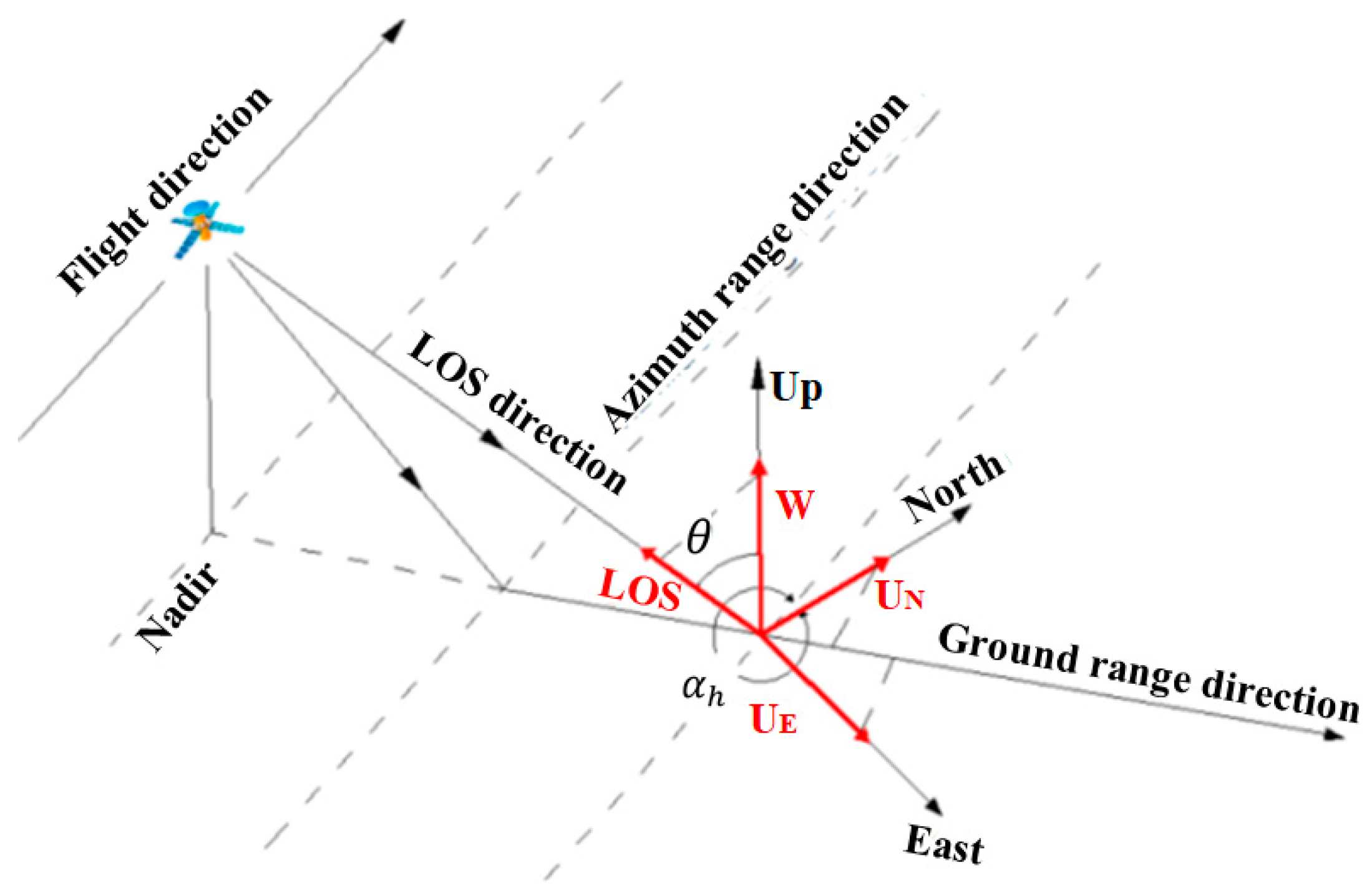
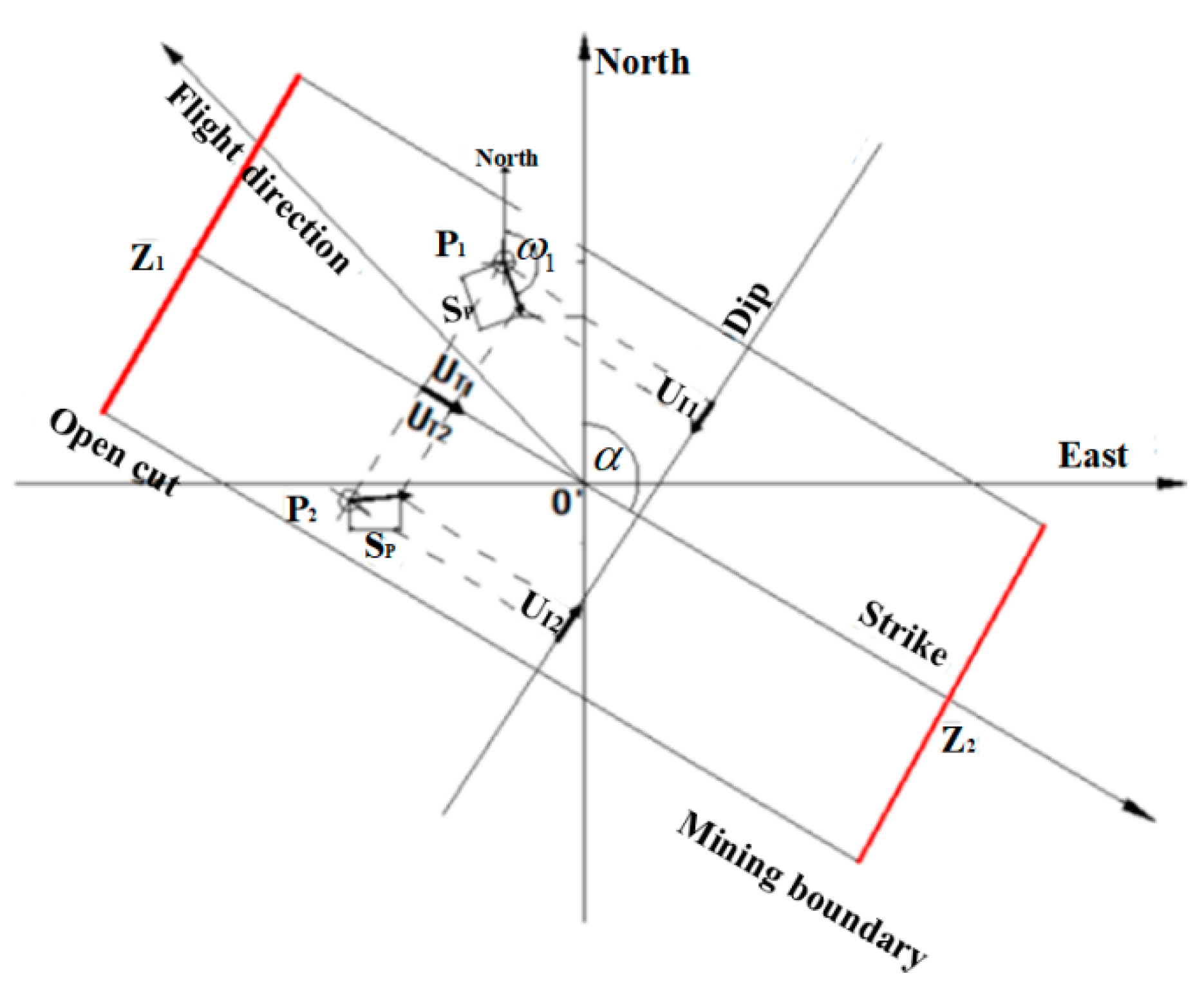
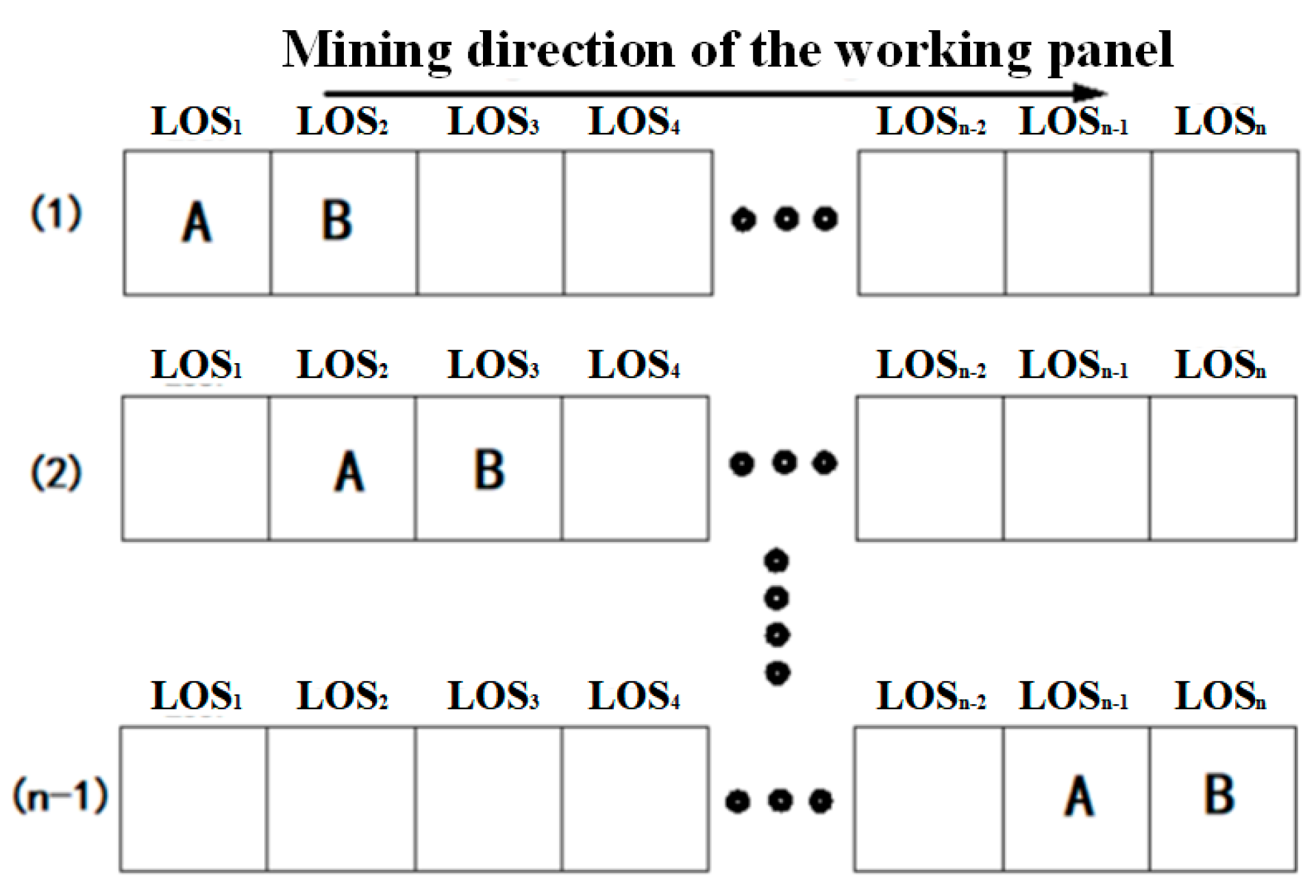
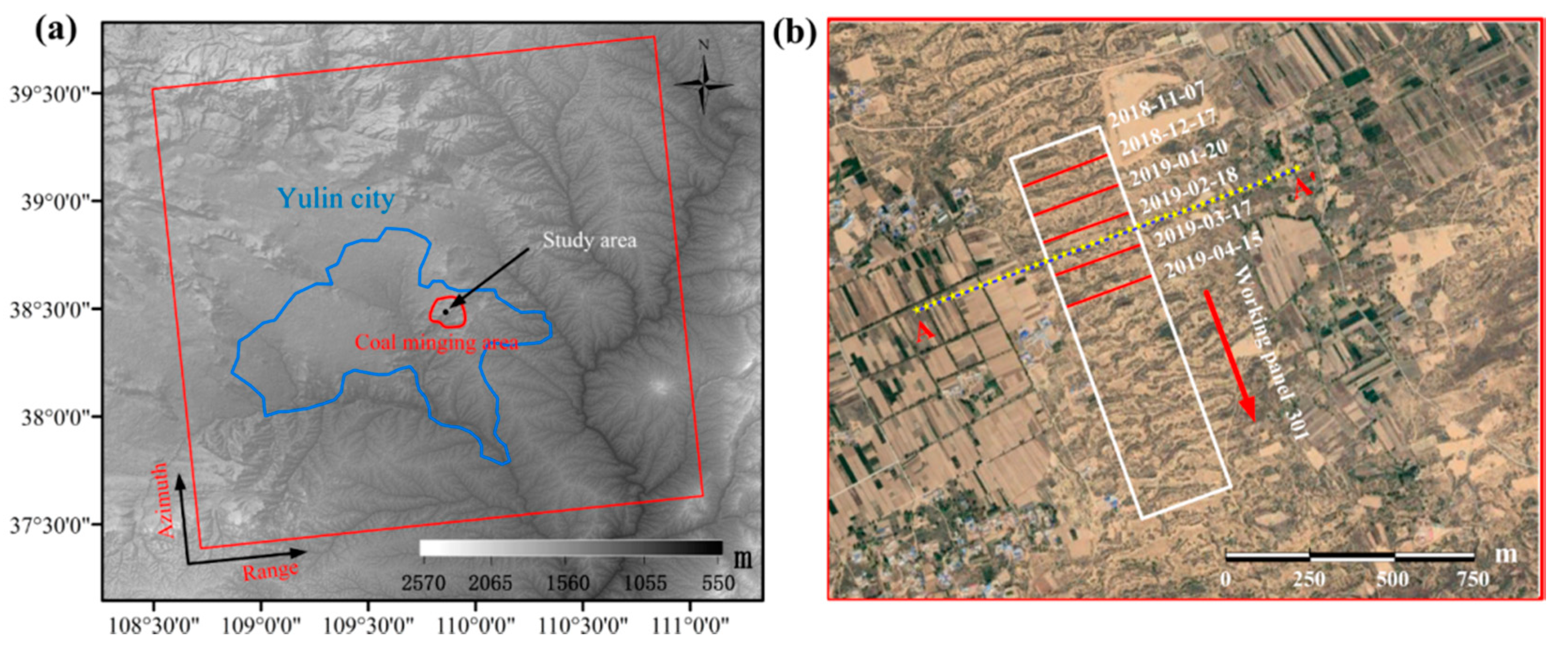
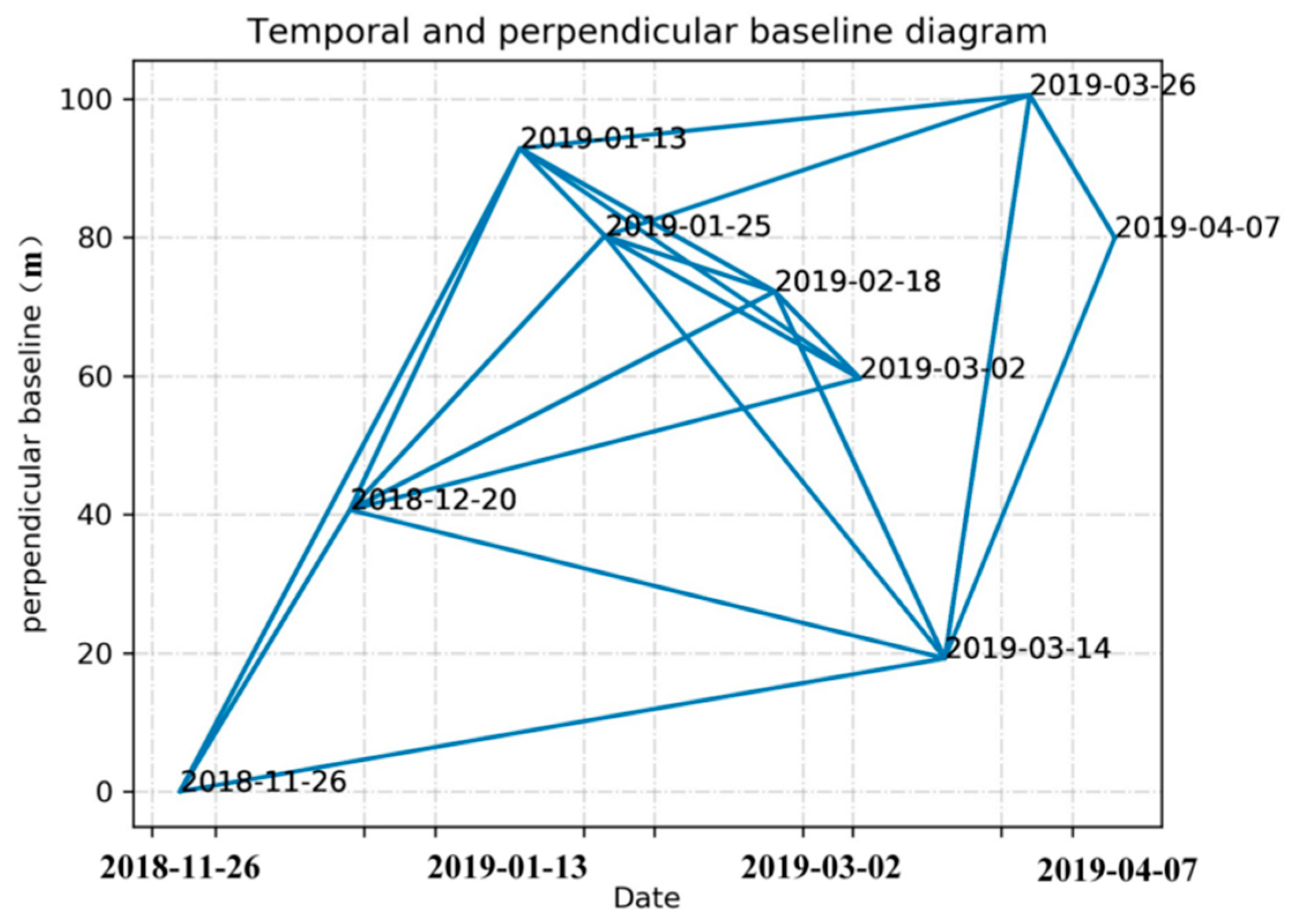

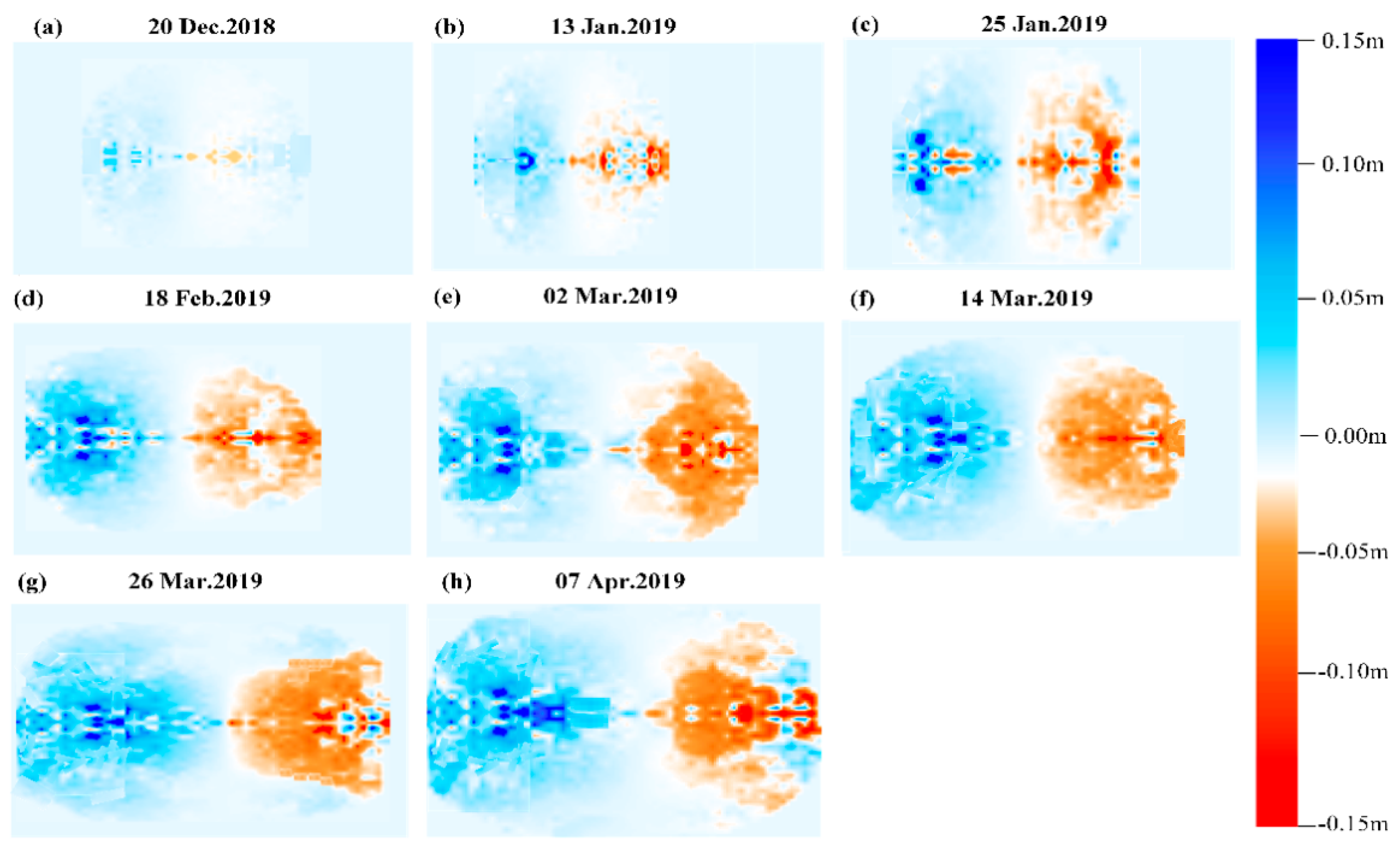
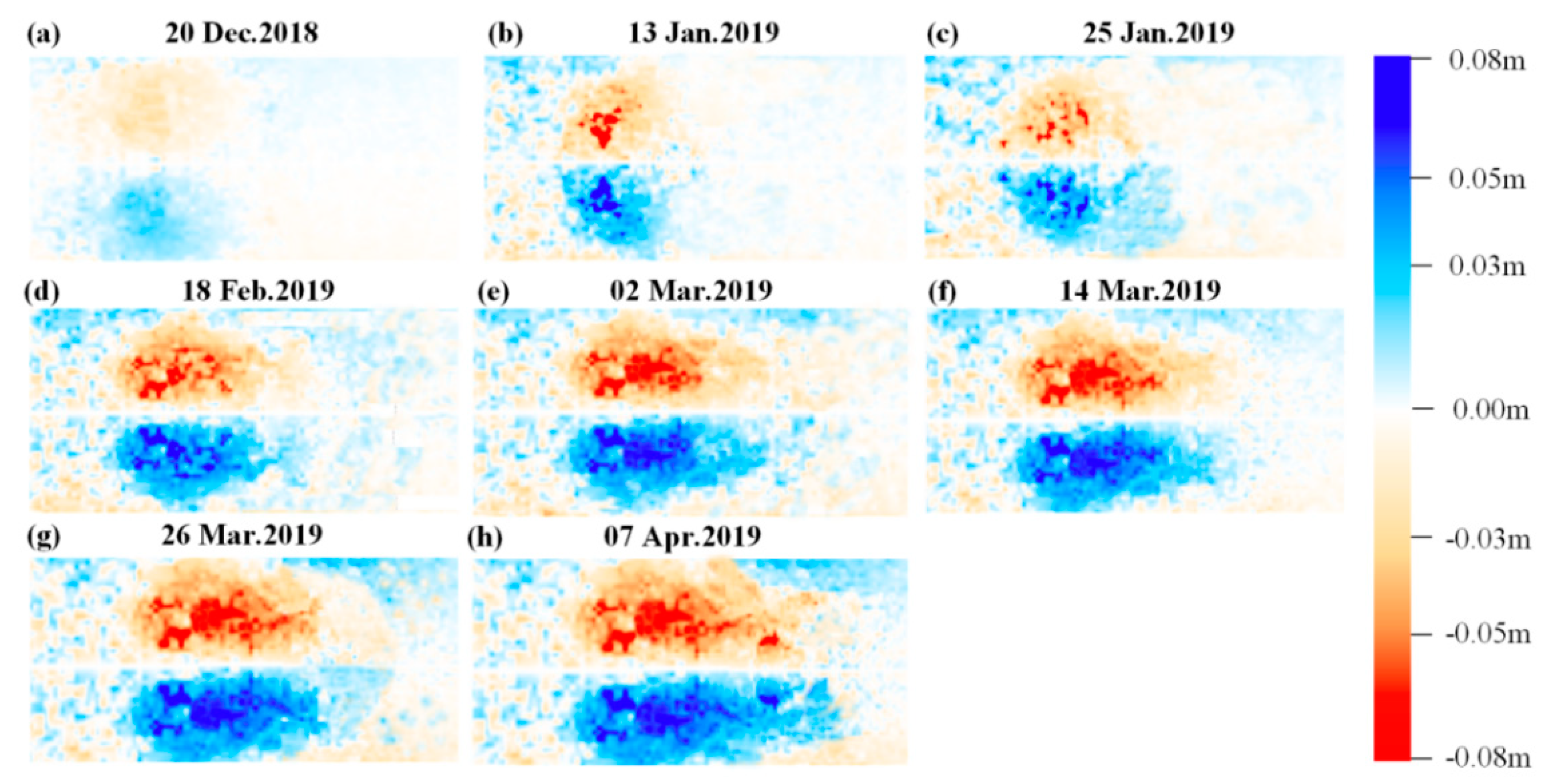
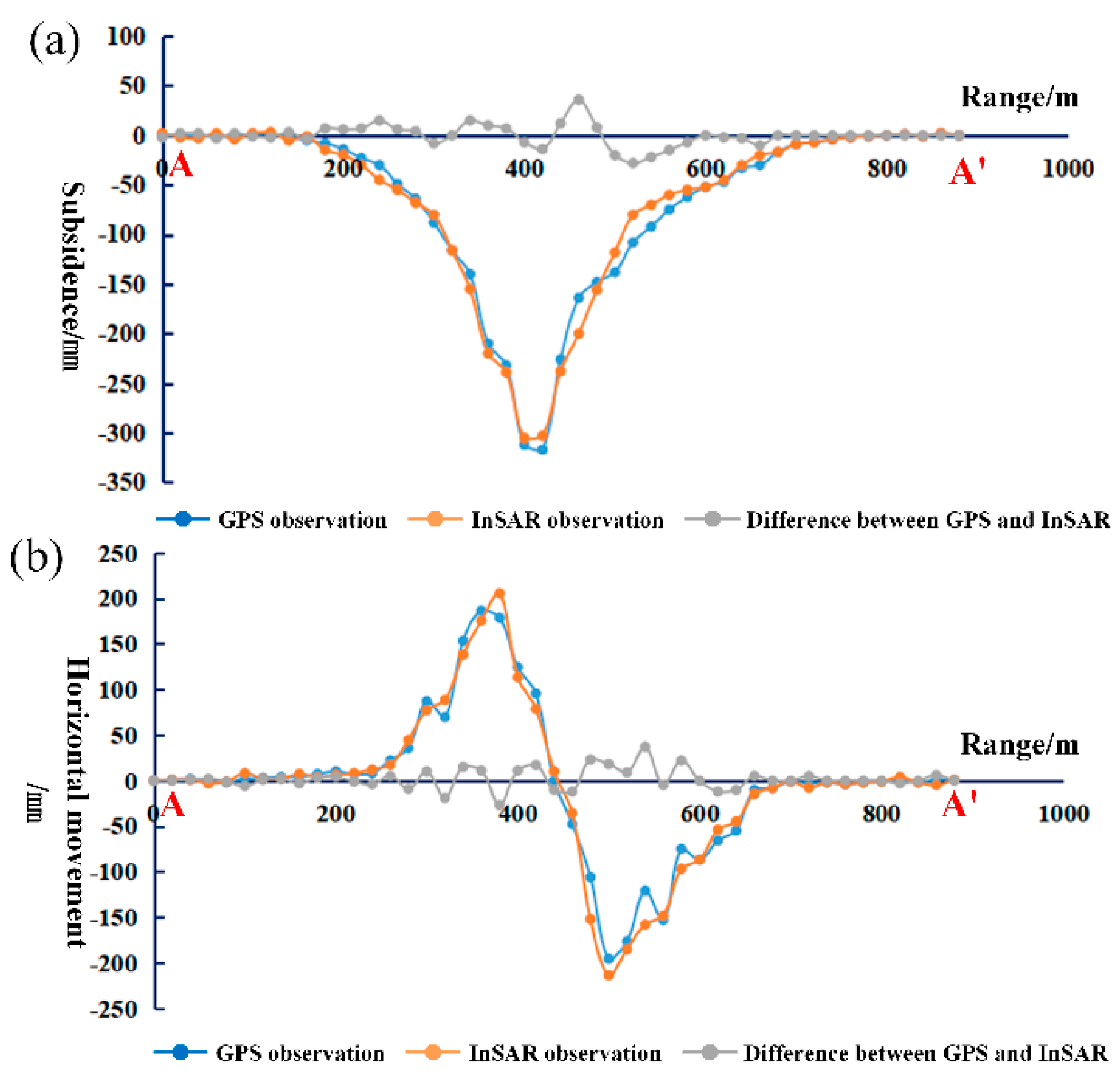
Publisher’s Note: MDPI stays neutral with regard to jurisdictional claims in published maps and institutional affiliations. |
© 2021 by the authors. Licensee MDPI, Basel, Switzerland. This article is an open access article distributed under the terms and conditions of the Creative Commons Attribution (CC BY) license (https://creativecommons.org/licenses/by/4.0/).
Share and Cite
Dong, L.; Wang, C.; Tang, Y.; Tang, F.; Zhang, H.; Wang, J.; Duan, W. Time Series InSAR Three-Dimensional Displacement Inversion Model of Coal Mining Areas Based on Symmetrical Features of Mining Subsidence. Remote Sens. 2021, 13, 2143. https://doi.org/10.3390/rs13112143
Dong L, Wang C, Tang Y, Tang F, Zhang H, Wang J, Duan W. Time Series InSAR Three-Dimensional Displacement Inversion Model of Coal Mining Areas Based on Symmetrical Features of Mining Subsidence. Remote Sensing. 2021; 13(11):2143. https://doi.org/10.3390/rs13112143
Chicago/Turabian StyleDong, Longkai, Chao Wang, Yixian Tang, Fuquan Tang, Hong Zhang, Jing Wang, and Wei Duan. 2021. "Time Series InSAR Three-Dimensional Displacement Inversion Model of Coal Mining Areas Based on Symmetrical Features of Mining Subsidence" Remote Sensing 13, no. 11: 2143. https://doi.org/10.3390/rs13112143
APA StyleDong, L., Wang, C., Tang, Y., Tang, F., Zhang, H., Wang, J., & Duan, W. (2021). Time Series InSAR Three-Dimensional Displacement Inversion Model of Coal Mining Areas Based on Symmetrical Features of Mining Subsidence. Remote Sensing, 13(11), 2143. https://doi.org/10.3390/rs13112143





